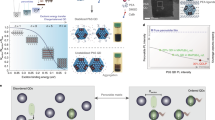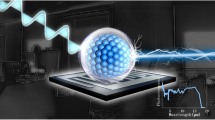Abstract
Colloidal quantum dots (CQDs) are emerging as promising materials for constructing infrared sources in view of their tunable luminescence, high quantum efficiency and compatibility with solution processing1. However, CQD films available today suffer from a compromise between luminescence efficiency and charge transport, and this leads to unacceptably high power consumption. Here, we overcome this issue by embedding CQDs in a high-mobility hybrid perovskite matrix. The new composite enhances radiative recombination in the dots by preventing transport-assisted trapping losses; yet does so without increasing the turn-on voltage. Through compositional engineering of the mixed halide matrix, we achieve a record electroluminescence power conversion efficiency of 4.9%. This surpasses the performance of previously reported CQD near-infrared devices two-fold, indicating great potential for this hybrid QD-in-perovskite approach.
This is a preview of subscription content, access via your institution
Access options
Subscribe to this journal
Receive 12 print issues and online access
$209.00 per year
only $17.42 per issue
Buy this article
- Purchase on Springer Link
- Instant access to full article PDF
Prices may be subject to local taxes which are calculated during checkout




Similar content being viewed by others
Change history
26 February 2016
In the version of this Letter originally published online, in Fig. 4a, the label on the y axis was incorrect. This error has been corrected in all versions of the Letter.
References
Bourdakos, K. N., Dissanayake, D. M. N. M., Lutz, T., Silva, S. R. P. & Curry, R. J. Highly efficient near-infrared hybrid organic-inorganic nanocrystal electroluminescence device. Appl. Phys. Lett. 92, 90–93 (2008).
Sun, L. et al. Bright infrared quantum-dot light-emitting diodes through inter-dot spacing control. Nature Nanotech. 7, 369–373 (2012).
Medintz, I. L., Uyeda, H. T., Goldman, E. R. & Mattoussi, H. Quantum dot bioconjugates for imaging, labelling and sensing. Nature Mater. 4, 435–446 (2005).
Sargent, E. H. Infrared quantum dots. Adv. Mater. 17, 515–522 (2005).
Kim, K.-H. et al. Phosphorescent dye-based supramolecules for high-efficiency organic light-emitting diodes. Nature Commun. 5, 4769 (2014).
Sekine, C., Tsubata, Y., Yamada, T., Kitano, M. & Doi, S. Recent progress of high performance polymer OLED and OPV materials for organic printed electronics. Sci. Technol. Adv. Mater. 15, 034203 (2014).
Shirasaki, Y., Supran, G. J., Bawendi, M. G. & Bulović, V. Emergence of colloidal quantum-dot light-emitting technologies. Nature Photon. 7, 13–23 (2013).
Supran, G. J. et al. High-performance shortwave-infrared light-emitting devices using core–shell (PbS–CdS) colloidal quantum dots. Adv. Mater. 27, 1437–1442 (2015).
Tessler, N., Medvedev, V., Kazes, M., Kan, S. & Banin, U. Efficient near-infrared polymer nanocrystal light-emitting diodes. Science 295, 1506–1508 (2002).
Zhitomirsky, D., Voznyy, O., Hoogland, S. & Sargent, E. H. Measuring charge carrier diffusion in coupled colloidal quantum dot solids. ACS Nano 7, 5282–5290 (2013).
Choi, J. J. et al. Photogenerated exciton dissociation in highly coupled lead salt nanocrystal assemblies. Nano Lett. 10, 1805–1811 (2010).
Moroz, P. et al. Infrared emitting PbS nanocrystal solids through matrix encapsulation. Chem. Mater. 26, 4256–4264 (2014).
Greenham, N., Peng, X. & Alivisatos, A. Charge separation and transport in conjugated-polymer/semiconductor-nanocrystal composites studied by photoluminescence quenching and photoconductivity. Phys. Rev. B 54, 17628–17637 (1996).
Steckel, J. S., Coe-Sullivan, S., Bulović, V. & Bawendi, M. G. 1.3 μm to 1.55 μm tunable electroluminescence from PbSe quantum dots embedded within an organic device. Adv. Mater. 15, 1862–1866 (2003).
Ning, Z. et al. Quantum-dot-in-perovskite solids. Nature 523, 324–328 (2015).
Hu, L. et al. PbS colloidal quantum dots as an effective hole transporter for planar heterojunction perovskite solar cells. J. Mater. Chem. A 3, 515–518 (2015).
Jeon, N. J. et al. Compositional engineering of perovskite materials for high-performance solar cells. Nature 517, 476–480 (2015).
Shi, D. et al. Low trap-state density and long carrier diffusion in organolead trihalide perovskite single crystals. Science 347, 519–522 (2015).
Hines, M. A. & Scholes, G. D. Colloidal PbS nanocrystals with size-tunable near-infrared emission: observation of post-synthesis self-narrowing of the particle size distribution. Adv. Mater. 15, 1844–1849 (2003).
De Mello, J. C., Wittmannn, H. F. & Friend, R. H. An improved experimental determination of external photoluminescence quantum efficiency. Adv. Mater. 9, 230 (1997).
Xing, G. et al. Long-range balanced electron- and hole-transport lengths in organic-inorganic CH3NH3PbI3 . Science 342, 344–347 (2013).
Burgelman, M., Nollet, P. & Degrave, S. Modelling polycrystalline semiconductor solar cells. Thin Solid Films 527, 361–362 (2000).
Zhitomirsky, D . et al. Engineering colloidal quantum dot solids within and beyond the mobility-invariant regime. Nature Commun. 5, 3803 (2014).
Acknowledgements
This publication is based in part on work supported by an award (KUS-11-009-21) from the King Abdullah University of Science and Technology (KAUST), by the Ontario Research Fund Research Excellence Program, and by the Natural Sciences and Engineering Research Council (NSERC) of Canada. X.G. thanks Mitacs for a Globalink Graduate Fellowship Award. The authors thank L. Levina for assistance in CQD synthesis; X. Lan, E. Yassitepe and F. Fan for acquiring microscopic images; and E. Palmiano, R. Wolowiec, and D. Kopilovic for their help during the course of study.
Author information
Authors and Affiliations
Contributions
X.G., Z.Y., Z.N., and E.H.S. designed and directed this study. X.G. and Z.Y. contributed to all the experimental work. G.W. and E.B. carried out the PLQE measurements and analysis. R.C. performed PL decay measurement and analysis. V.A., O.V. and X.G. performed optoelectronic simulation. X.G., Z.Y., R.C., and E.H.S. wrote the manuscript.
Corresponding author
Ethics declarations
Competing interests
The authors declare no competing financial interests.
Supplementary information
Supplementary information
Supplementary information (PDF 1548 kb)
Rights and permissions
About this article
Cite this article
Gong, X., Yang, Z., Walters, G. et al. Highly efficient quantum dot near-infrared light-emitting diodes. Nature Photon 10, 253–257 (2016). https://doi.org/10.1038/nphoton.2016.11
Received:
Accepted:
Published:
Issue Date:
DOI: https://doi.org/10.1038/nphoton.2016.11
This article is cited by
-
Vapour-deposited perovskite light-emitting diodes
Nature Reviews Materials (2024)
-
Bright and stable near-infrared lead-free perovskite light-emitting diodes
Nature Photonics (2024)
-
Recent Advances in Patterning Strategies for Full-Color Perovskite Light-Emitting Diodes
Nano-Micro Letters (2024)
-
Mid-infrared cascade intraband electroluminescence with HgSe–CdSe core–shell colloidal quantum dots
Nature Photonics (2023)
-
Large-area waterproof and durable perovskite luminescent textiles
Nature Communications (2023)



